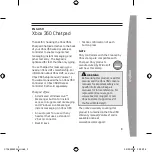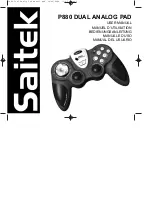
Auto - backlit is turned on for 30 secs when any key is pressed.
Liquid Crystal Display
In normal operating mode, the upper LCD displays the current sensor
temperature and the lower LCD displays the setpoint temperature. The display is
also used with the
Up
and
Down
key
to adjust the setpoint temperature,
differential and heating/cooling modes of the operation.
LCD Blue Backlit Options:
set by slide switch on the front panel
ON - backlit is turned on.
OFF - backlit is turned off.
The base has standard 7/8” (22mm) knockouts which accept common wiring
hardware and conduit fittings. Before removing the knockouts, check the wiring
diagrams and use the chamber with common voltages.
ROUGH-IN WIRING
Loosen the screws on the top and bottom of the enclosure and remove the wiring
covers by swinging them away from the base(grey color) with the edges of the
covers as pivot(see Figure 1).
Figure 1
Side view
Heating Mode and Cooling Mode:
set by keypad
The control output will turn on when the sensor temperature falls to the setpoint
temperature minus the differential amount. The control output will turn off when the
sensor temperature reaches the setpoint temperature. For example, if setpoint =
68F, Differential = 3F, then output is on at 65F and off at 68F. In other words, when the
heating mode is chosen, the differential is below the setpoint. The relay will de-
energize as the temperature rises to the setpoint. Refer to Figure 2.
The control output will turn on when the sensor temperature rises to the setpoint
temperature plus the differential amount. The control output will turn off when the
sensor temperature reaches the setpoint temperature. For example, if setpoint =
75F, Differential = 2F, then output is on at 77F and off at 75F. In other words, when
cooling mode is chosen, the differential is above the setpoint. The relay will de-
energize as the temperature falls to the setpoint.
Heating Mode
(factory setting):
From the isolated SPDT relay output, “NO” are normally open contacts which close
and “NC” are normally closed contacts which open when the control output is on.
Cooling Mode
:
The control output turned on means:
RED light indicates that the SPDT relay output is energized.
L.E.D. SYSTEM STATUS INDICATION LIGHTS:
The single stage models (DST-777S, DST-777D) offer optimum control by
means of a Pulse Width Modulation(PWM). In PWM, the ON and OFF cycle
vary depending on the difference between the sensor and setpoint
temperature. The bigger difference between the sensor and setpoint
temperature, the longer the relay is switched ON. When the sensor
temperature approaches the setpoint temperature, the ON time become
shorter and shorter. Pulse Width Modulation guarantees precise control
response. This function prevents overshoots and undershoots in systems
with large thermal mass (eg. slabs or pools).
Figure 3 shows the operation of relay on Heating Mode during PWM cycle:
!
If the sensor temperature is half of the PWM Differential below the
setpoint temperature (in this example is: 71 F (75 - 8/2), relay is ON.
°
!
°
°
If the sensor temperature is between 71 F and 79 F , PWM is in action.
When the sensor temperature crosses the rising slope of the triangle
wave generated by the control, relay is turned ON during the shaded
region. When the sensor temperature passes the falling slope of the
triangle wave, the relay is turned OFF during the unshaded region.
!
The pulse width (the relay ON time within one cycle) is modulated in
according to how far the sensor temperature deviates from the setpoint
temperature.
!
If the sensor temperature is half of the PWM Differential above the
setpoint temperature (in this example is: 79°
F (75 + 8/2), relay is OFF.
!
If sensor temperature is the same as the setpoint temperature, the pulse
width is half (50%) of the cycle length.
!
If the sensor temperature is higher than the setpoint temperature, the
pulse width allows shorter period of ON time
Pulse Width Modulation (PWM)
Mode(PWM CONTROL): Set PWM slide
switch to ON
!
If PWM mode is selected, the minimum time delay is disabled.
!
If the sensor temperature is lower than the setpoint temperature, the
pulse width allows longer period of ON time.
!
The principle of operation on Cooling Mode is the same with the shaded
and white area reversed in Figure 3.
Setpoint
= 75 F
°
Time
Sensor Temperature Curve
PWM Cycle Length
PWM Differential
= 8 F
°
Grey Area = ON region
White Area = OFF region
Relay Turned Off
Relay turned On
Figure 3: Operation of relay on heat mode during Pulse Width Modulation(PWM) cycle
71 F
°
Temperature
79 F
°
(Pulse width)
ON (relay energized)
Setpoint
OFF
(relay de-energized)
ON
OFF
Temperature
+
-
Heating
Mode
Cooling
Mode
Figure 2: Operation of relay in according to Setpoint and Differential
Settings for both Heating and Cooling Mode
Normal Control Mode(ON/OFF Control):
Set PWM slide switch to OFF
The control outputs will turn on the equipment when there is a demand for
heating or cooling. When the demand is satisfied, the control outputs will turn
it off.
OPERATION
Anti-Short Cycle Delay can be set to ensure the output relay remains off for up
to 20 minutes (default is 0 mins) after relay is de-energized. This is adjustable
from 0 to 20 min with 1 minute increments. In other words, this function
establishes the minimum time that the output relay remains de-energized
before the next on-cycle. It does not allow the output relay to re-energize until
the programmed time delay has elapsed. The delay is activated when the
control is first turned on, but can be skipped during the display of “1SP.S” at
startup by pressing the “SET” key once and go to normal operating mode
(Note: SET key at this stage will not perform any other function except
terminating the time delay).
Anti-Short Cycle Delay is available only when
PWM is off .
Anti-Short Cycle Delay:
set by keypad
When the delay is activated, the Upper LCD shows the current temperature
and the lower LCD shows blinking “AC” which stands for Anti-Cycle. Also, in
case there is a demand for heating/cooling, the red LED for relay output will be
blinking indicating that anti-cycle feature prevents relay from energizing.






















